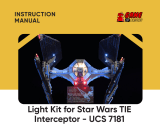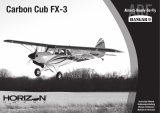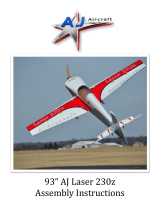Page is loading ...

84” Turbo
Bushmaster
Copyright 2016 Extreme Flight
1

Please take a few moments to read this instruction manual before
beginning assembly. We have outlined a fast, clear and easy method
to assemble this aircraft and familiarizing yourself with this process
will aid in a quick, easy build.
Please read the following paragraph before beginning assembly of
your aircraft!
THIS IS NOT A TOY! Serious injury, destruction of property, or even
death may result from the misuse of this product. Extreme Flight RC
is providing you, the consumer with a very high quality model aircraft
component kit, from which you, the consumer, will assemble a flying
model. It is beyond our control to monitor the finished aircraft you
produce. Extreme Flight RC will in no way accept or assume
responsibility or liability for damages resulting from the use of this
user assembled product. This aircraft should be flown in accordance
to the AMA safety code. It is highly recommended that you join the
Academy of Model Aeronautics in order to be properly insured, and to
operate your model at AMA sanctioned flying fields only. If you are
not willing to accept ALL liability for the use of this product, please
return it to the place of purchase immediately.
Extreme Flight RC guarantees this kit to be free of defects in materials
and workmanship for a period of 30 DAYS from the date of purchase.
All warranty claims must be accompanied by the original dated
receipt. This warranty is extended to the original purchaser of the
aircraft kit only.
Extreme Flight RC in no way warranties its aircraft against flutter. We
have put these aircraft through the most grueling flight tests
imaginable and have not experienced any control surface flutter.
Proper servo selection and linkage set-up is absolutely essential.
Inadequate servos or improper linkage set up may result in flutter and
possibly the complete destruction of your aircraft. If you are not
experienced in this type of linkage set-up or have questions regarding
servo choices, please contact us at info@extremeflightrc.com or 770-
887-1794. It is your responsibility to ensure the airworthiness of your
model.
2

Congratulations on your purchase of the Legacy Aviation Turbo
Bushmaster! Our intention with the Legacy line of aircraft is to
provide unique sport-scale aircraft that are easy to assemble and fun
to fly. These models possess gentle flight characteristics for the
novice-to-intermediate sport flyer while also being capable of
advanced aerobatics for the more experienced pilot.
The Turbo Bushmaster is loosely based on the full scale Turbo
Beaver. The Turbo Beaver is a well known and loved aircraft among
bush pilots capable of STOL takeoffs and landings. The Turbo
Bushmaster is capable of these same maneuvers and so much more!
Big and light, the Bushmaster is as gentle and forgiving as any trainer
we've ever flown, making for a very enjoyable and relaxing flying
experience. Flip the rate switches and the model transforms into an
extremely capable aerobat! Experiment with the various flap mixes
that are possible and you open up a whole new envelope of high
lift/high drag maneuvers.
3

Let’s begin!
Wing Assembly
Wing Hardware:
4

1. Locate the 2 wing panels as well as the composite aileron and
flap control horns. Use sandpaper to scuff the portion of the
control horn that will be glued into the surface. For a more
finished look you may wish to paint your control horns before
installation. We used a black Sharpie to perform this task with
great results. Do not paint the portion of the control horn that
will glue into the control surface!
5

2. Using a soldering iron or a SHARP hobby knife, remove the
covering from the slots for the aileron and flap horns.
3. Dry fit the horns into their respective slots and trim any debris
from the slot until the control horn seats properly against the
control surface.
4. Apply 30-minute epoxy to the aileron and flap control horn slots
and to the scuffed area of the control horns. It may be helpful to
use a zip tie to push the epoxy into the slots.
6

5. Install the control horns into their respective slots and wipe
away any excess epoxy with a paper towel or cloth soaked with
denatured alcohol.
6. In these next steps we will install the hinges. Please take a few
moments to familiarize yourself with this process if you have not
installed hinge points before.
There are several ways to do this and several adhesives you can
use. We will describe the way that we do it, as this method has
proven itself over many years of model building. If you are new
to this type of hinging process, then I recommend that you
install a single hinge first just to acquaint yourself with this
method
Before starting you will need to gather a few items to aid you as
you proceed.
A. 30 Minute Epoxy
B. A short length of pushrod or small dowel.
C. A roll of paper towels
D. Denatured alcohol or Acetone
E. Hobby Knife
F. Silicon lubricant
7

7. Locate a wing panel and separate the control surfaces from the
main wing and remove the hinges.
8. Mix up a generous batch of epoxy and use a piece of pushrod or
dowel to apply the epoxy to the hinge hole.
9. Apply epoxy to the barbed section of the hinge on one side and
insert it into the hole until the center of the hinge is centered on the
hinge line. Using a paper towel soaked with acetone or denatured
alcohol wipe away any epoxy that has been squeezed out of the
hole.
8

10. Make sure the hinge can move freely and that the pin is aligned
properly before the epoxy sets! When you are satisfied with the
results set the surface aside so that the epoxy will pool around the
rear of the hinge. When you are comfortable with this process you
should be able to do one side of a surface per batch of epoxy.
Repeat the process to attach the surfaces to each wing. There
should be as little gap as possible while still allowing maximum
movement of the control surface.
11. As a final step before setting the wing aside to dry, do a final
cleaning of the hinge knuckles with a paper towel soaked with
denatured alcohol or acetone to remove any epoxy residue. If you
find any of the hinges are stiff after drying, apply a drop of acetone
to each hinge with a Q-tip and move the surface back and forth
several times to loosen it up. As a final step I typically apply a
couple drops of silicone lubricant to each hinge. This is available
at most home improvement and hardware stores. DO NOT USE A
PETROLEUM BASED LUBRICANT AS IT WILL DEGRADE THE
INTEGRITY OF THE NYLON HINGE!
9

12. You will need to attach a 12" servo extension to your aileron
servo to reach the wing root. The flap servo wire will reach the root
with no extension attached. Secure the extension to the servo lead
with heat shrink tubing or a wire keep.
13. Use the manufacturer supplied mounting hardware to install
the servos with the output shaft toward the LEADING EDGE of
the wing. Electronically center the servo and install 1.25" servo
arms onto the servo spline. The servo arms should be parallel
to the hinge line when centered. It is very important that you
use the same length servo arms for both flap and aileron
servos .
10

14. Thread the supplied ball links onto each end of the 4 pushrods.
Placing the pushrod into your electric drill and using it to thread
the pushrod into the ball link makes this task much easier. Be very
careful not to screw the pushrod in too far and damage the ball
link!
15. Use the supplied 2mm bolts, washers and nuts to affix the
pushrod to the servo arm and control horn. It is imperative to
attach the ball link to the bottom of the servo arm to achieve full
deflection.
11

16. Locate the wing fences and trail fit on the wing. Some
sanding may be required for best fit. While the fences are
temporarily installed on the wing use 2 pieces of painters tape to
mark their location on each side of the fence. This will aid in
alignment and prevent excess glue from getting on the covering.
12

17. Use 30 min epoxy to attach the fences. Wipe away any excess
epoxy with a paper towel soaked in acetone. Be sure to remove
the tape before the epoxy fully cures. Repeat this process for the
other wing panel.
13

Main Landing Gear Assembly and Installation
Tools Required for this step
12mm Wrench
8mm Wrench or Nut Driver
2.5mm Hex Driver
1.5mm Hex Driver
Thread locker
Painters tape
Sharp hobby knife
Welders adhesive or Goop
18. Locate the landing gear fairings and black rubber tubing. You
will need to slice the tubing lengthwise on one side. Use a sharp
hobby knife and starting at one end gently cut through only one
wall of the tubing being careful not to cut through the second side.
Once the tubing has been cut place it around the top of the landing
gear faring and secure it with CA
14

19. Locate the carbon landing gear, axles, wheels and fasteners
from the landing gear hardware package.
15

20. Attach the landing gear to the fuselage using the supplied
bolts and washers. The landing gear has a slight airfoil, make
sure that the thicker part of the gear is facing the nose of the
airframe.
16

21. Slide the gear fairings into place against the bottom of the
fuselage. Use a piece of painters to mark their location.
Remove the fairing and apply a thick bead of Goop to the carbon
gear just above the tape line. Slide the fairing back into place
and secure with tape until dry.
17

22. Locate the 2 axles, 2 locking nuts, 2 wheels, 4 wheel collars
and 2 washers and mount the wheels as shown.
18

Horizontal Stab and Elevator Assembly
Stab/elevator Hardware kit
19

23. Locate the horizontal stabilizer/elevator assembly. Turn it upside
down on the building table and remove the covering from the control
horn slot on the RIGHT side (This will be the Left side when installed).
Glue the control horn in place with 30 minute epoxy.
24. Insert the elevator section Upside-down and backwards into
the Stab/Elevator slot
20
/




